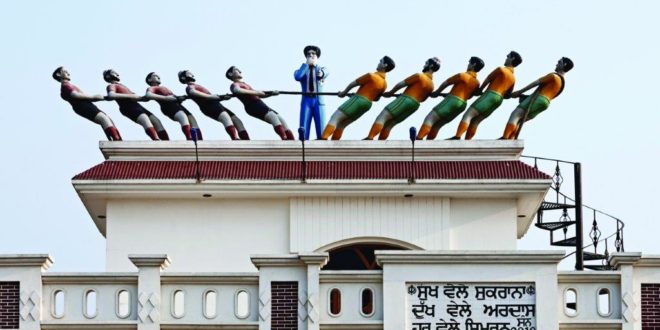This spring, Surrey Art Gallery is hosting the photography exhibition Rajesh Vora: Everyday Monuments in April. The exhibition documents Mumbai-based photographer Rajesh Vora’s domestic sculptures mounted on rooftops in the northwestern Indian state of Punjab that tell a story of identity, diaspora, family, and culture. Made from rebar, wire mesh, cement, and paint, many of these intriguing objects serve as functional water tanks.
While Greater Vancouver has a Punjabi population established more than a century ago, it was during the latter half of the twentieth century that an increasing number of Punjabi villagers migrated to other parts of the world. Canada was one of their chosen destinations. Many return to India for seasonal visits, keeping close ties with families remaining in the villages and helping to finance the making of these houses. The houses themselves are an intricate mix of various styles, genres, and historical periods. Several stories high, they signal a shift from the traditional one-story courtyard-style house. Together, the unique houses with their rooftop embellishments break with conventional design boundaries. They show how art, architecture, and everyday life meld together. Vora’s photographs are an important record of this cultural expression of the Punjab that is all but unknown beyond India.

The sculptures installed on top of the houses are emblems of pride. They often represent personal and commemorative family symbols. For example: My grandfather had the first tractor in the village; my son is a weightlifter; we took Air Canada to reach our new home; we bought a Maruti car; my father was in the Indian army. These anecdotes reveal that these domestic sculptures are more than an artistic or architectural phenomenon. They tell a diasporic story that has echoes around the world.
This phenomenon is distinct to Punjabi villages, gaining popularity in the 1980s. At that time, local artists precast these sculptures from a mould that usually took the form of airplanes, falcons, and footballs. Over the years, artists have custom fabricated the sculptures for each homeowner, resulting in more diverse and elaborate works of art.
The exhibition is displaying more than one hundred of these sculptures in Rajesh Vora: Everyday Monuments. Birds, soccer balls, airliners, automobiles, army tanks, weightlifters, pressure cookers, lions, and horses are among the varied objects.
Rajesh Vora: Everyday Monuments is guest curated by Keith Wallace and is made possible with financial support from the Hamber Foundation, Hari Sharma Foundation, and Zheng Shengtian Art Foundation. South Asian Studies Institute is a community partner. This exhibition is part of the 2022 Capture Photography Festival Selected Exhibition Program.
Both Vora and Curator Wallace had discovered these intriguing sculptures during their visits to Punjab. They joined hands in 2019 to bring this work to the world.

While explaining why he was attracted to this subject, Vora said, “I had heard so much about the NRIs and how they changed the rural village landscape in Punjab, but there was hardly any visual documentation. For me, it was a discovery in 2014 when travelling in Punjab on an assignment documenting stories about global migration. I witnessed a unique scene—at a place of worship popularly known as the Airplane Gurdwara, devotees offered plastic toy planes in the hope of quickly obtaining a visa to leave India. While there, I heard rumours of immigrants who were successful in gaining a visa and then returning to their village and placing a sculpture of an airplane upon their newly built homes, which, for me, was a more fascinating story. The toy planes are a symbol of hope, while the sculptures are a symbol of achieving that hope.”
“Intrigued, I made frequent trips to the Doaba region, popularly termed Punjab’s NRI hub. This fascination turned into excitement and soon a visual obsession. As I travelled looking for these airplanes, I was glad that I had no map, GPS, a guide, address, or available research. I crisscrossed over 150 villages, making six trips and travelling 7,500 km through four districts—a hunch, a hint, a friendly nod, a passing glimpse, a silhouette or at times just aimless driving was all that I needed to discover these sculpted water tanks in rural Punjab,” he added.
Wallace has travelled to India more than a dozen times over thirty years and artists of South Asian descent he has exhibited in Vancouver include Shani Mootoo, Sunil Gupta, Vivan Sundaram, Subodh Gupta, and Anita Dube.
“Rajesh Vora has visited close to 150 Punjabi villages since 2014 to document these amazing sculptures,” notes Keith Wallace, curator of this exhibition. “With Surrey being the hub of BC’s Punjabi population, Surrey Art Gallery is the natural location to exhibit his photographs.”
Surrey Art Gallery is hosting the exhibition from April 9 to May 29. Admission is free.
 Desi Today Magazine
Desi Today Magazine




